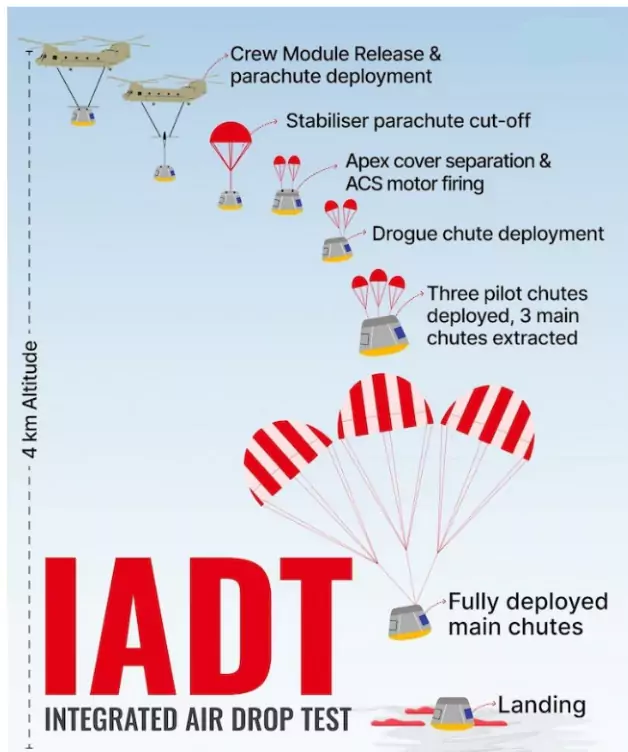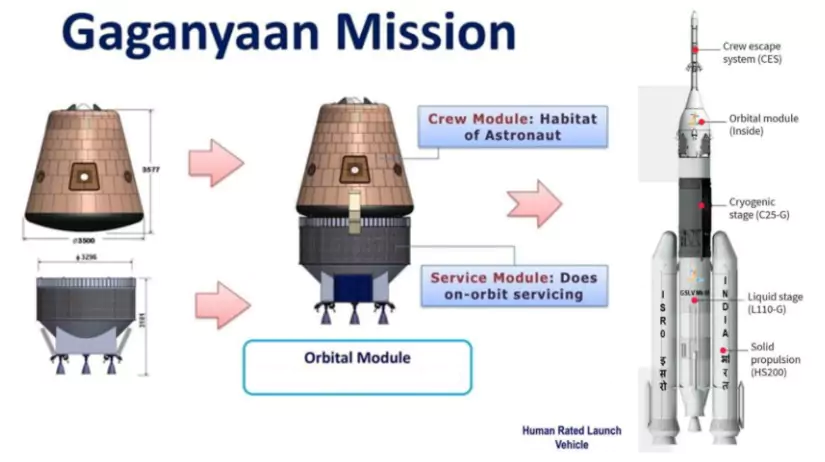ISRO successfully carried out an Integrated Air Drop Test simulating the re-entry, parachute deployment, and sea recovery of the Gaganyaan crew module, marking a key milestone for India’s first human spaceflight mission.

- Parachute System: Designed by DRDO; part of a 10-parachute configuration for actual flights.
About Integrated Air Drop Test (IADT-01)
- Aim: To evaluate the end-to-end parachute deployment sequence, including: Extraction, Drogue chute activation, Main parachute deployment.
- Method: A dummy crew capsule (~5 tonnes) is dropped from an Indian Air Force Chinook helicopter to validate the system’s performance
What Is a Re-entry Test Mission?
A re-entry test mission is an uncrewed or experimental flight focused on demonstrating that a spacecraft can:
- Safely survive hypersonic atmospheric re-entry, managing extreme heat and aerodynamic stress.
- Reliably deploy deceleration systems, like parachutes, to slow down for a controlled descent.
- Be recovered successfully, either via splashdown in water or soft landing on land.
|
About the Gaganyaan Mission
Overview of Mission
- Flagship Human Spaceflight Project of ISRO.
- Goal: Send a crew to low Earth orbit (~400 km) and safely return them to Earth.
- Aim: Demonstrate India’s human spaceflight capability and strengthens its position in space technology.
Objectives of the Mission
- Human Space Capability: Validate India’s ability to launch astronauts into orbit and ensure safe return.
- Scientific & Educational Impact: Inspire careers in Science, Technology, Engineering, and Space among Indian youth.
Launch Vehicle & Technology
- Vehicle: GSLV Mk III (LVM-3), modified as Human-Rated LVM-3 to meet crew safety standards.
- Propulsion System: Three-stage system — solid, liquid, and cryogenic stages.
- Safety Features: Equipped with Crew Escape System (CES) and Orbital Module.
Astronaut Training
- Selected astronauts will train in Russia.
- Training includes preparation for weightlessness and operation in space conditions.
Integral Components of the Gaganyaan Spacecraft
Orbital Module (OM)
- The Orbital Module will orbit the Earth and consists of two parts: the Crew Module (CM) and the Service Module (SM). It is fitted with advanced avionics and built with redundancy for reliability.
- Crew Module (CM):
- Designed as a habitable space with an Earth-like atmosphere.
- Equipped with control systems, crew communication, navigation, guidance, and avionics.
- Built with a double-wall rigid structure: a pressurized metallic inner structure and an unpressurized outer shell with a Thermal Protection System (TPS).
- Contains life support, human-centered systems, avionics, crew interfaces, and deceleration systems.
- Designed for safe re-entry into Earth’s atmosphere.
- Service Module (SM):
-
- Provides essential support to the Crew Module in orbit.
- An unpressurized unit containing propulsion, power, thermal systems, avionics, and deployment mechanisms.

Crew Escape System (CES)
- Ensures astronaut safety in case of emergencies.
- Tested through the Flight Test Vehicle Abort Mission-1 (TV-D1), which validates the ability to separate the Crew Module from the rocket during a mid-flight emergency.
Phases of the GAGANYAAN Mission
ISRO has structured the mission into multiple phases for safety and reliability:
- Test Phase:
- Integrated AirDrop Test (IADT): Validates parachute + deceleration systems.
- Pad Abort Test (PAT): Checks escape system by dropping Crew Module from different heights.
- Test Vehicle (TV) Flights: Single-stage liquid rocket used to test abort functions.
- Unmanned Missions
- Conducted before the human mission to test technology, safety, and reliability.
- Includes airdrop tests, abort system validation, and flight trials.
- Water Survival Test Facility (WSTF): Initial recovery tests with the Indian Navy.
- Vyommitra: A humanoid robot designed to fly on unmanned missions before human spaceflight.
- Manned Mission: The final phase will carry Indian astronauts into space, following the two unmanned test flights.
![]() 25 Aug 2025
25 Aug 2025



